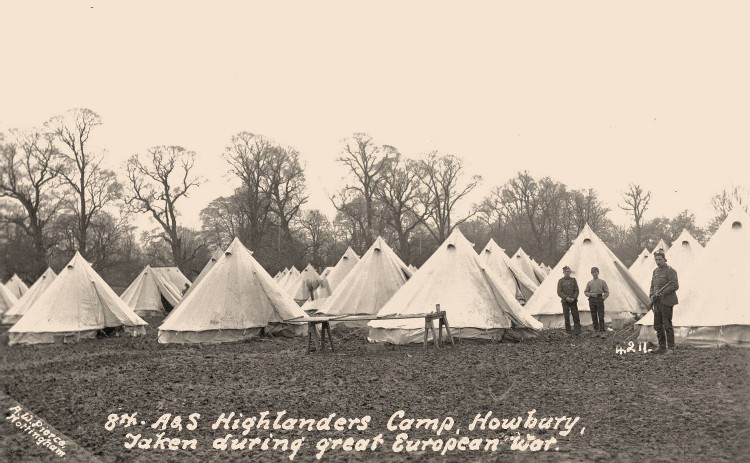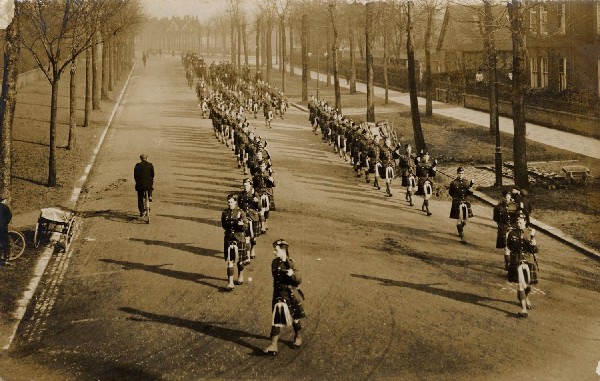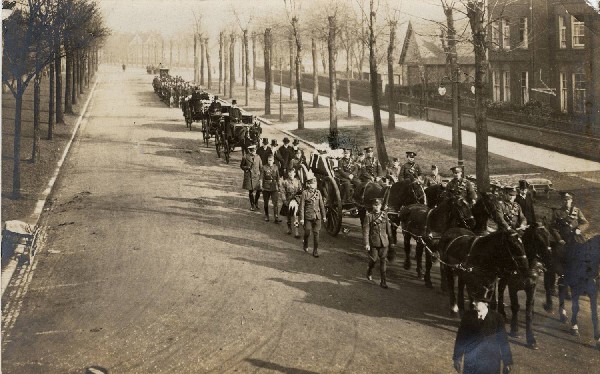Bedford Highlanders
Death and Disease
Places > Bedford > First World War > Regiments | Bedford Highlanders Home

Although the division's time in Bedford was largely
trouble free in terms of disciplinary matters, tragedy
came in the form of disease. Scarlet Fever, diphtheria
and measles ran through the ranks of men who had never
been exposed to these diseases in the more remote areas
of Scotland. The majority of men who contracted these
diseases survived, but some did not. At the time, the
numbers of deaths became grossly exaggerated and it was
rumoured that considerable numbers of men were dying in
large measure as a result of incompetence and lack of
concern on the part the Authorities.
The landladies
who had sick soldiers living in their homes would often
not permit the men to be sent to hospital, trusting
themselves to do a better job than the authorities of
tending the sick.
"Measles broke out among the
machine gun men and the signallers and machine gun men
were isolated at Howbury... unfortunately I managed to
catch the measles. After spending 2 days of torture in
the tent I was sent to Clapham Hospital... and was
there 3 weeks. Meanwhile most of the other companies in
the 1/8th Battalion had caught the measles too and the
Battalion was isolated at Howbury (under canvas) with
Howbury Hall as Head Quarters."
The personal
diary of Private Hugh McArthur, Signaller, 1/8th Argyll
and Sutherland Highlanders
This photograph (Bedford &
Luton Archives and Records Service) shows the tented
quarantine camp in the grounds of Howbury Hall, Renhold.
Nearly 1,000 men of the 8th Argyll and Sutherland
Highlanders lived in these tents for most of the winter
of 1914/15 while the measles epidemic ran its course.
(photo:
Bedford and Luton Archives and Records Service)

It is reckoned that just under 150 men died of disease
during the winter spent in Bedford. In the majority of
cases, their bodies were returned to Scotland for
burial, but some 33 are interred in the military section
of Bedford's Foster Hill Road cemetery.
This
photograph is of a Seaforth Highlander's funeral
procession and was taken at the junction of Park Avenue
and Foster Hill Road. The firing party, with rifles
reversed, are just turning into Foster Hill Road to lead
the cortege up the hill to the cemetery. The firing
party is followed by the pipes and drums. During the
winter of 1914/15 Bedfordians became very familiar with
the strains of 'Flowers of the Forest', a traditional
Highland lament, played by the pipers as the bodies of
the dead soldiers were carried through the Town either
to the railway station to make the journey home to
Scotland, or up to Foster Hill Road cemetery.
Such
was the public concern over the deaths among the
Highlanders that the authorities felt compelled to
publish a full explanation in the pages of the
Bedfordshire Times.
"OFFICIAL FIGURES
So many
rumours have been prevalent of late, many of them
grossly exaggerated, as to the number of deaths of
Scottish Territorials, that it seems desirable to give
the actual figures.
This we ('The Bedfordshire
Times') are enabled to do, having before us, by the
courtesy of Major Keble, D.A.D.M.S., H.D. (T.F.), the
vital statistics relating to the Highland Division T.F.,
in Bedford from August 17, 1914 to January 9, 1915... the
total number of deaths from all causes up to January 9,
1915, 39".
(photo:
Bedford and Luton Archives and Records Service)

"These figures should at once and definitely put a
stop to all the talk of 'hundreds of deaths.' The
average number of troops quartered in and around Bedford
during the past five months has been about 17,500, and
the total number of deaths works out at the low rate of
2.2 per 1,000 men.
The largest number of deaths, it
will be seen, is due to measles, and it may be said at
once that this danger was foreseen. The real difficulty
as to measles, and some other infectious diseases,
arises in the case of men like the Camerons, who come
from the Western Highlands and Isles, where such
diseases are unknown.
They have no such resisting
power as is built up in town-bred populations which for
generations have been subject to the disease. When they
get measles it goes very hard with them, and the disease
is utterly unlike that which we know in the case of our
children. This is unavoidable, according to the official
military medical authorities. All that can be done is
done.
The men who have been in contact with
measles and are susceptible are removed to the Huts at
Howbury. Then, if they are attacked, they are removed to
the Measles Hospitals at Goldington Road and Ampthill
Road.
The official medical view is that the number of
deaths, deeply regrettable as it is, is not large under
the circumstances; and all the evidence goes to show
they are right."
This photo which is next in the
sequence shows the coffin, draped with the Union Flag
and borne on a gun carriage belonging to the Highland
artillery. Such scenes were reasonably commonplace in
Bedford during the winter of 1914/15.
(photo:
Bedford and Luton Archives and Records Service)
Page last updated: 30th May 2014
